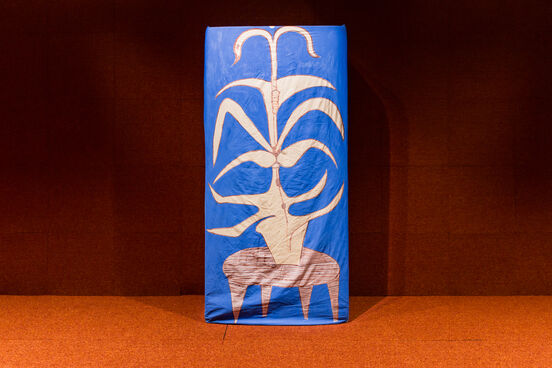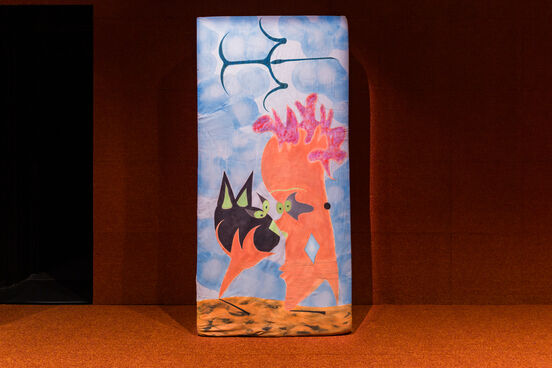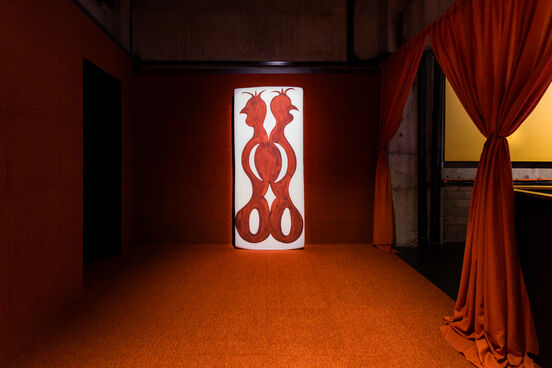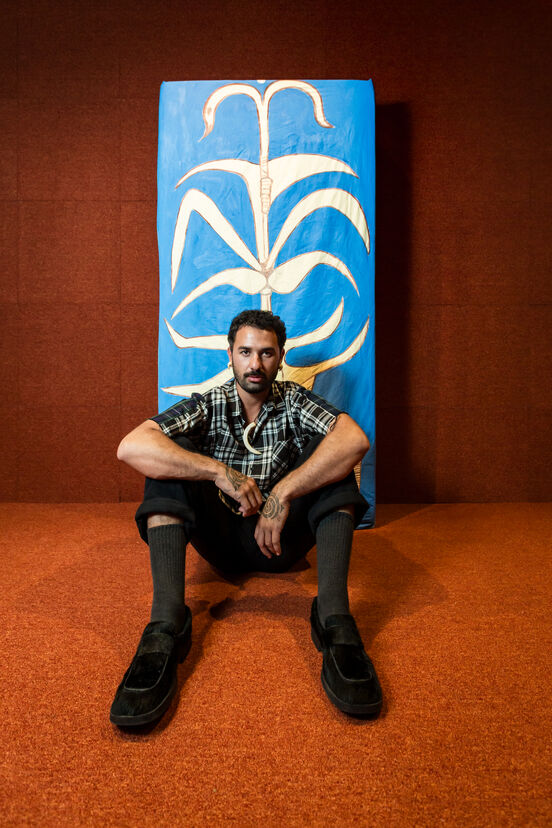-
Author
Te Aōrere Delilah Parore-Southon -
Date
4 Nov 2024
Essay
An Ode to Te Rūma Moenga – The Mattress Room
Republished from Casula Powerhouse
Written by Te Aōrere Delilah Parore-Southon (Te Roroa, Te Kuihi, Ngāpuhi, Ngāti Tūwharetoa, Te Whakatōhea) for Casula Powerhouse, Sydney on the occasion of Te Rūma Moenga / The Mattress Room (Memory Foam) by Tyrone Te Waa (Ngātī Tūwharetoa). Republished by Objectspace on the occasion of How to make a home, which features two of Te Waa’s mattress works.
—
Once upon a Friday in the middle of Raumati, two Kuia sat in the wharekai at the marae. They awaited manuhiri to arrive for a hui, it was the hush before the whanau chaos. They sat opposite each other, blowing smoke, as they read each other's Tarot cards to the tune of Bill Withers singing about sunshine. They got lost in daydreams, in a spiral of moemoea from their tūpuna, they drifted into the visions of their childhood spent running down by the river that bordered the marae. They spoke of the mystic wonders of Mahuika; the Atua wahine, half-bird, half-woman with fire fingers, who held the epitome of radiant healing power. They fell into the feeling of abundance, and noted how she gives in the form of fiery power and feminine essence. An essence that fills the hearts of those who hear her karanga — they weaved her wisdom into their minds as if they were a foam mattress laid upon the floors of the wharenui, soaked with the ahua of a thousand lifetimes, a thousand people, and the whakapapa of the unborn mokopuna.
The evening was one in which fairytales were fantasised to fill; a lavender haze kissed the whare tapu of Tūwharetoa sacred whenua. The sun setting in an ode to Ngātoroirangi. The maunga were dusted with orange and violet hues, as Tāwhirimatea blew a breeze from the west that touched skin like itchy orange carpet.
One Kuia had bright purple hair, and the other had long grey-witchy-locks that she braided into plaits. Their withered hands laden with Pāua shell rings, subtle wrinkles, and storyteller smiles, they dealt tarot cards gently, in the same manner they poured their G&T’s — strong, with certainty. They hummed waiata of the old people, ‘he kainga tupu, home sweet home’ and laid their minds to moemoea from a bygone era.
The two kuia cooed over their mokopuna, debated whakapapa, and howled at the local hangi-pants going after their cousin one night at Turangi RSA. The cousin who went porangi after going on a wahi-tapu at night. They continued to dish card upon card, laying them on the 1950’s Rimu table: layered with white doily netting, and a burnt-orange plastic tablecloth. The table was its own adorned taonga: a third generation heirloom. An organised chaos; plastic flowers from the Taumarunui op-shop, 2 week old baked chocolate-raisin slices leftover from Whaea Mere’s tangi, unsung lotto tickets, pamphlets on astrology classes, a council letter about increased water rates, an ashtray, and seashells from a trip to visit some Ngāpuhi relatives.
As the moon drew its evening breath, the kōrero poured out of their mouths as if it were the sacred waters of Maui. They emptied their hearts, and locked eyes as if they were in the embrace of the Atua. They cackled into the evening as they formed the pou of aroha, upon the whenua of their ancestral right. They spoke of their Grandmothers, and how the mattress room in the wharenui was a sacred place for children to dream, learn and imagine their future. They reiterated that a whole world could be envisaged in the confinement of four walls of the mattress room. So small, but brimmed with 30 mattresses – a space where dreams and stories become a canvas of potential, an abundant garden, watered by imagination. The mattress room was the closest thing Māori got to the Pākeha fairytale, The Princess and The Pea. They held true to the fact that there comes a time as you grow, that you stop seeing the mattress room as the haven of dreamscape, and more part of the realities of adulthood and cultural duty. Like metamorphosis; from fairytale, to chore and responsibility — lore, to law.
The Kuia’s walked out of the wharekai and into the wharenui to begin their manaakitanga responsibilities, preparing for the manuhiri, setting out beds, and vacuuming— tasked with readying the mattresses for their whanau. The sight of a Kōtare caught their eye in the distance, it sat upon the waharoa, at the entrance. Its prime position as waewae tapu, a bringer of ancient karakia: a tohu. The Kōtare held the Kuia in trance as they stood at the foot of the wharenui, weaving colours, sounds, and whispers of the whenua as they delicately formed like sea foam, into Te Rūma, the room — it felt as if they were on a maiden voyage guided by the whetū from Raiatea.
Instinctively bowing their heads as they entered the whare, nodding to the mana of the house, just as their Grandmothers did. The dimly lit walls, adorned with photos of their tūpuna, the Kuia paid homage. As they reached the back of the whare, and placed the key into the Mattress Room door, they were both awakened to a familiar scent: 1960’s nostalgia, and the reminder of unfulfilled childhood dreams.
The sweetened scent of plastic mattress coverings, musk, mothballs and dust woven with old bed sheets cleansed their thinking. A reminder of who they were in the present day, due to those who had paved the way before them. As they began to run their hands across the mattresses, they were stopped in their tracks. The mix of a violet, and burnt orange haze wafted from the corners of the room . “Aueeee!”, they both exclaimed in the warmth of an unexpected hazy delight.
The mattresses took human form, as if they were Atua. As if their tarot cards had to come to greet them. Breathing life in colour, shape and mystic form, as wondrous figures unknown to the everyday eye of humans. Through a slight blue mist, they became tikanga. Mana rose to the ceiling, aroha drew her gaze, pono offered ritual, and manaakitanga draped her Korowai over the Kuia. A potent feeling of belonging reminded them of who they were, and ancient karakia was echoed from the whenua below them: ‘Te Rūma Moenga, heke iho, heke iho, tupuna wairua rā’.
Coming back to reality, the Kuia looked at each other and knew what to do. Tuturu! For they realised the meaning of being grazed by such radiance. A reminder of their youth, their beautifully wrinkled hands doting subtleness prompted the potential for their mokopuna – limitless. The truest essence of moemoea, and a surrealist abyss. For, the mattress room, like memory foam, reminded them to always draw a smiley-face on the sun, to collect ancient weeds and be spellbound by all dreams, and to listen to the Kōtare when it comes as tohu with a poem ripped from the mattress seams.
As they left the whare, the cackling began again — this time, louder than before. “Holy heka, hono heke” the Kuia cried “Jeeez, do our moemoea make us porangi? Are we crazy for having wild dreams?”.
They got in the car, turned on Erykah Badu, rolled a smoke, and drove to the Taumarunui RSA. When they arrived, the space between their thoughts was clear: it was time to begin to illuminate their world with a new delicate light. To use the voice with no words, and be the timeless conduit — to bring forth the pou found within the sacred whare of wairua.
To find a new world, you have to have lost one or be lost. The ritual of renewal is the ritual that makes a new world, and perhaps the ritual is found at the altar of dreams where it was left in the mattress room, in the waltz with the Atua, or at the edge of the river where your tūpuna once danced.
Te Moemoea wairua, te Moemoea wairua, te ngakau moemoea
Heke iho, heke iho
Puhiwahine ngakau moemoea
He mana atua, mana tangata, mana wairua, mana whenua
Heke iho, heke iho
Tūpuna rā wairua
—
Glossary of teo reo Māori kupu in text:
KUIA — ELDERLY WOMAN, GRANDMOTHER, FEMALE ELDER NGATOROIRANGI – EPONYMOUS ANCESTOR OF TE ARAWA WAKA MOEMOEA – TO HAVE A DREAM, VISION
MANAAKITANGA – TO GIVE, TO LOOK AFTER, TO CARE
AHUA – SHAPE, FORM, ESSENCE, FEELING
TIKANGA – TRIBAL CUSTOMARY TRADITION, VALUES
POU – CENTRE POINT, FIXED, ELEVATE
RAUMATI — SUMMER TANGI – FUNERAL, MOURNING CEREMONYATUA – MAORI DEITY / GODS
MOKOPUNA — GRANDCHILD, REFLECTION OF GRANDPARENT WHAKAPAPA — GENEALOGY, CONNECTION POINT, LINEAGE, DESCENT MAUNGA — MOUNTAIN, ANCESTOR
WHENUA — LAND, ANCESTRAL LANDS, PLACE OF BIRTH
MANUHIRI — VISITORS HUI — MEETING / GATHERING
WHANAU – FAMILY / CLOSE CONNECTIONS, TO BE BIRTHED






Tyrone Te Waa, Te Rūma Moenga - The Mattress Room, Casula Powerhouse 2024, photographs by Chantel Bann